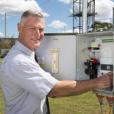
Originally from Switzerland, Dr Häusermann gained his PhD in x-ray diffraction and synchrotron techniques at King’s College London.

Showing 421 - 440 of 538 results

Originally from Switzerland, Dr Häusermann gained his PhD in x-ray diffraction and synchrotron techniques at King’s College London.

Andrew Douglas is Founder & Managing Director of Kandui Technologies.
Exploring the interaction of polystyrene nanoplastics and blood plasma proteins.

Role at ANSTO


Role at ANSTO
An environmental study supported by a citizen science project at ANSTO and UNSW has brought greater understanding of the movement of birds between all of Australia’s major water basins and the importance of the Murray-Darling River Basin.
The Australian Synchrotron has played a crucial role in the discovery of a new cancer drug for the treatment of leukaemia.
A collaboration of scientists from RMIT, ANSTO and the CSIRO has published pioneering research that brings new insights into intrinsically disordered proteins and protein regions (IDPs)/ (IDRs) and how they behave under various physiological processes.
Terry has studied in Singapore and Australia, focusing on teaching design. He is passionate about cross-cultural interactive learning and design research to inspire new and innovative concepts.
A world-first processing technology developed in collaboration by ANSTO’s Minerals unit.
A team of Melbourne researchers and international partners from Italian Instituto Nazionale de Fisica Nucleare (INFN) and CERN, who are developing radiation-hardened semiconductor chips, used the unique state-of-art high energy ion microprobe on the SIRIUS ion accelerator at ANSTO’s Centre for Accelerator Science to test a prototype radiation-resistant computer chip
A unique scientific capability comprising a single research platform for high-fidelity simulation, real-time dosimetry, and biological response data is available all from a neutron instrument.
Clarity Pharmaceuticals is building on comprehensive work on chelators carried out at ANSTO.

ANSTO scientist, Dr Klaus Wilcken of the Centre for Accelerator Science, used cosmogenic nuclide dating to determine the ages of layered sand and gravel samples, in which seven footprints of the flightless bird, the moa, were found on the South Island in New Zealand in 2019.